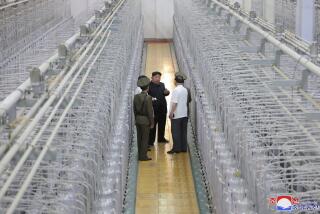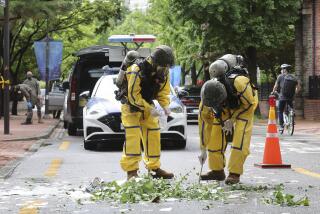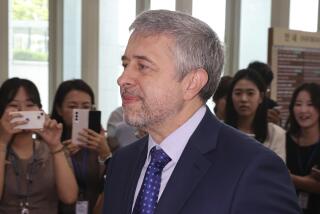A trip to North Korea offers curious sites
Reporting from Pyongyang, North Korea — Visiting North Korea is like peering in the window of a store that closed long ago but where old merchandise mysteriously remains. I walk through the aisles feeling privileged, fascinated and curious, a little nervous, but not scared.
It is unlike any other place in the world. Communications and information technology most of the rest of the world takes for granted -- the Internet, cellphones, GPS systems -- are unavailable to civilians. North Korean-sanctioned news about Western nations often is characterized by violence and aggressive government actions.
Business brought me here in June, making me one of a very few Americans who have seen close-up the world’s most restricted nation. U.S. citizens are allowed to visit, but as tourists, they are limited to traveling between August and October, during the Arirang Festival, also known as the “mass games” (see sidebar).
In my four days here, all accompanied by government escorts, I will see perhaps the most curious tourist attraction in the world: Late on a Friday afternoon, I’m negotiating my way through the narrow passageways of an American spy ship.
The USS Pueblo, docked at the edge of the Taedong River in the North Korean capital of Pyongyang, is the government’s proud trophy of its resistance against “the aggression of U.S. imperialists.” A female military officer greets me and, in near-perfect English, beckons me across the gangplank.
Once on deck, I feel as though I’m prying open a Cold War time capsule.
First, I watch an 18-minute film on the capture of the crew and ship in January 1968, complete with patriotic music and grainy black-and-white footage of President Johnson denying that the Pueblo had been on an espionage mission. Jagged holes on the ship’s hull, circled in red paint, provide a stark reminder that mortar and machine gun fire from four torpedo boats and a submarine chaser were necessary to secure the now 65-year-old vessel.
The radio room is a cramped collection of vintage communications technology, with steel-cased radios, their green displays long-faded and brown knobs chipped and worn. A manual typewriter collects dust in the corner. In glass display cases, there are boots worn by Capt. Lloyd Bucher and the crew’s handwritten letter to Johnson urging him, despite his public statements, to concede that they really had been spying. The Americans’ letter was coerced by their captors, according to one surviving officer.
Our 40-minute tour ends at the ship’s stern with our guide, the petite military officer, answering questions in soft but precise tones alongside one of the Pueblo’s machine guns. I’m feeling a bit rushed, but our government “escorts” are insistent: We cannot be late for the next attraction -- a gymnastics show with jump-roping bears.
Inside North Korea, all is orderly -- a “workers’ paradise” for most of the 23 million residents, with no unemployment and little crime.
In this paradise, no one needs an alarm clock. Rather, each day at 5 a.m., in cities and rural areas, residents awake to patriotic music blaring through speakers, followed by a woman’s haunting voice urging people to work hard, thereby enhancing the beauty and greatness of their society. And, of course, honoring “The Eternal President of the Republic,” Kim Il Sung, and his son, Gen. Kim Jong Il, the current leader.
On arrival
A massive portrait of the elder Kim, “the Great Leader,” greets arriving visitors from the roof of the Sunan International Airport. Once my luggage is scanned, visa inspected and cellphone impounded, I meet my assigned escorts, settle into a Toyota SUV and drive 15 miles into the capital city. The few vehicles on the road are owned either by the government or the military. Most people walk in groups of five or 10; others ride bicycles.
One of the first landmarks entering the city is the Arch of Triumph built in 1982 to commemorate Korea’s resistance to the Japanese occupation from 1910 to 1945. The structure is modeled after the Arc de Triomphe in Paris but is a bit larger -- intentionally. I glance at my visa and realize a drawing of the arch is reflected in a holographic image on the document.
Streets are swept several times a day. One morning we drive by Kim Il Sung Square, one of many monuments honoring the nation’s founder. The plaza, more than 800,000 square feet, is nearly 10 times the size of San Francisco’s Union Square. But there are no panhandlers or even pigeon droppings. In contrast, we witness more than 200 people on their hands and knees scrubbing the plaza’s concrete floor -- a sight I will never forget.
The work of my employer, World Vision, a Christian humanitarian organization, has brought me here, so we drive into the countryside to visit schools and hospitals benefiting from World Vision-funded programs. We pass roadside monuments, several feet tall, proclaiming the date Kim Il Sung stood there and provided local residents “on-the-spot guidance.”
Outside Pyongyang, collective farms are ubiquitous. Large murals exhort the people to work diligently. Farmers use oxen to plow the land or perform tasks by hand with rakes and shovels. Tractors, combines and other modern agricultural machinery? Nowhere to be seen.
Before the Pueblo tour, our escorts allow a visit to the Tower of Juche Idea, a monument constructed to honor Kim Il Sung’s 70th birthday. Built with precisely 25,550 concrete blocks (one for each day of his 70 years), the spire reigns high above the capital city. The tower was patterned after the Washington Monument but, like the Arch of Triumph, intentionally designed to be slightly taller. At night, the metal torch on top is illuminated, casting a 360-degree red light, a symbolic beacon of the nation’s ideology.
One cannot begin to understand North Korea without a grasp of its ideology, “Juche.” It is a combination of self-reliance, autonomy and independence. The individual and the nation are masters of their own destiny. Essentially, it is the state religion -- the cultural, social and political force designed to motivate and drive every thought, statement and action.
In fact, in North Korea, the year is not 2009; it is Juche 98, the 98th anniversary of Kim Il Sung’s birth.
Once atop the 558-foot Tower of Juche, I have an expansive view of the capital. Immediately below, across the Taedong River, is Kim Il Sung Square. The people scrubbing six hours earlier have been replaced by hundreds of gymnasts practicing. Some of them likely will be starring in what one Western tour guidebook calls “the most incredible show on Earth”: the Arirang Festival, commonly called “mass games.” Nearly 100,000 dancers, gymnasts, acrobats and other performers celebrate events such as the nation’s harvest season and its battle against the United States.
The festival is presented in the May Day Stadium. This skyline standout looks like something Frank Gehry might have designed early in his career. Its 16 sweeping, scalloped arches give the round building a space-age feel. The stadium holds 150,000 spectators and, for the annual festival, tourists reportedly spend upward of $450 for the best seats.
Traveling through Pyongyang late in the afternoon, one observes mini-orchestras on street corners. Groups of about 30 high school students perform patriotic songs, honoring workers as they walk or bicycle home from factories, government offices and rice fields outside the city.
Can you imagine a group of young musicians serenading drivers as they enter the Santa Monica Freeway?
The other striking presence on Pyongyang’s streets is the uniformed women directing traffic. Wearing perfectly tailored military-like garb, the women are a study in discipline and precision. They wield their batons deliberately. I never see a driver disobey their directives.
Traffic policewomen work in four-hour shifts, and one day I witness a shift change, in which the off-duty officer slowly and deliberately approaches the on-duty officer in the road. The on-duty officer stops all traffic, turns to face her colleague, their eyes meet, then they exchange places.
My hotel, the Koryo, is an imposing 1985 building with twin towers of 43 stories, more than 500 rooms and an expansive, nonsmoking lobby. It is designed for tourists and foreigners on business, and offers guests saunas, a workout room and a karaoke bar. There are five restaurants, including a revolving one atop one of the towers. In the evening, that red beacon from the Juche Tower is unmistakable.
No computers are available for visitors, and there is no Internet access. I could have sent an e-mail or made an international phone call, but this would have expensive. One also can browse the Koryo’s bookstore, where titles include “Kim Jong Il’s Views on Juche Idea.” The souvenir shop on the first floor, just off the reception desk, has handmade crafts, a foreboding bottle of some sort of liquor with a dead snake inside, and more.
My standard room has two firm full-size beds, a sitting area, a refrigerator stocked with sodas and beer and television with uncensored BBC News. The $100 rate includes breakfast Western style (an omelet, two slices of white bread and coffee or tea) or Korean (soup, noodles and kimchi).
Anyone visiting North Korea should bring cash -- U.S. dollars or euros. Credit cards are not accepted; there are no ATMs.
Thanks to the government guides, language is not an issue.
Priceless souvenir
On the last night in Pyongyang, we attend a banquet at the Arirang restaurant with our escorts and other government officials. The three gas grills at our table are busy for more than two hours roasting beef, pork, chicken and shrimp.
As with other formal dinners, the place settings include four glasses, one each for liquor, wine, beer and water. Waiters and waitresses bring large servings of rice, vegetables, noodles and varying types and flavors of the Korean staple, kimchi. The tab? About $200 for nine people.
The next morning, I arrive at the airport by 7:30 for the 9 a.m. Air Koryo flight to Beijing. Luggage is carefully inspected with scanners and by hand. Cellphones are returned, and, just as I’d been warned, my visa is removed from my passport.
Among the more than 500 photos on my 16-gigabyte flash card tucked away in my carry-on bag is an image of that visa, a priceless souvenir of this venture into the “workers’ paradise.”
latimes.com/pyongyang More glimpses Go online for more photographs.
More to Read
Sign up for The Wild
We’ll help you find the best places to hike, bike and run, as well as the perfect silent spots for meditation and yoga.
You may occasionally receive promotional content from the Los Angeles Times.






